Video of the Week:
Hydrangea Paniculat or PeeGee
Vegetables:
Rotation of Vegetable Crops
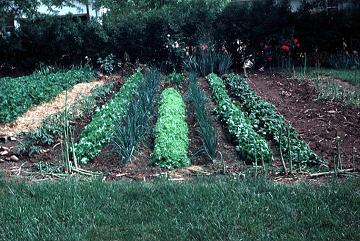
As mentioned earlier, it is also a good idea to avoid planting closely related crops in the same area as diseases may be shared among them. For example, tomatoes, potatoes, peppers and eggplant are closely related. Also, broccoli, cauliflower, cabbage and brussels sprouts share many characteristics in common. Therefore, do not plant cabbage where broccoli was the previous year or tomatoes where the peppers were.
So, why is this important to bring this up in the fall? Now is the time to make a sketch of your garden so that the layout is not forgotten when it is time to plant next year. (Ward Upham)
Ornamentals:
Preventing Sunscald on Thin-Barked Trees
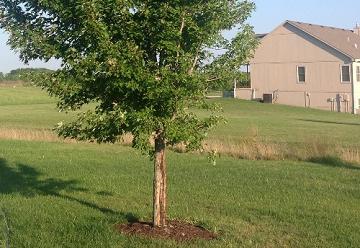
Trees often recover but need TLC — especially watering during dry weather. Applying a light-colored tree wrap from the ground to the start of the first branches can protect recently planted trees. This should be done in October to November and removed the following March. Failure to remove the tree wrap in the spring can prove detrimental to the tree. (Ward Upham)
Flowers:
Amaryllis, Bringing it back into Bloom
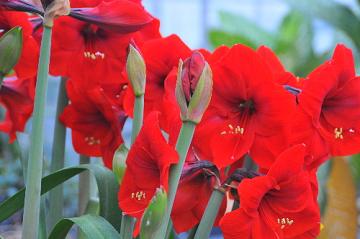
When you are ready for amaryllis to resume growth, water thoroughly and place the plant in a warm, sunny location. Do not water again until the roots are well developed because bulb rot is a concern. Amaryllis needs temperatures between 50 and 60 degrees during the period before flowering. Higher temperatures can weaken leaves. The flower bud may start to appear right away or the plant may remain dormant for a period of time, but eventually all mature bulbs do bloom if they have been given proper care during the growing season. Keep the plant in a cool location and out of direct sunlight when the flower buds begin to show color so that the flowers last longer. Amaryllis can remain in bloom for about a month. (Ward Upham)
Miscellaneous:
Harvesting and Curing Black Walnuts
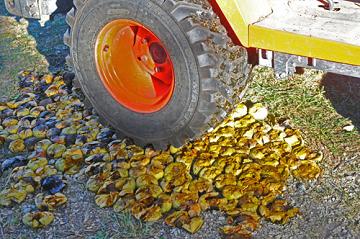
There are several ways to hull walnuts including running them through a corn sheller or pounding each nut through a hole in a board. The hole must be big enough for the nut but smaller than the hull. An easier way is to run over the nuts with a lawn tractor. This will break the hull but not crack the nut.
Note that walnut hulls contain a dye that will stain concrete, your hands or about anything else it touches. Wear gloves as the stain is almost impossible to remove. Wash hulled nuts by spreading them out on the lawn or on a wire mesh and spraying them with water or placing them in a tub of water. If you place them in a tub, the good nuts should sink. Those that float are probably not well-filled with kernels. Next, dry the nuts by spreading them in layers no more than three deep in a cool, shady and dry place such as a garage or tool shed. Drying normally takes two weeks. (Ward Upham)
Stratification
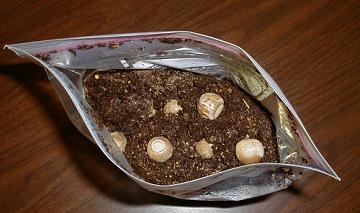
- Seed is immature and needs more time to develop;
- A mechanical barrier is keeping water from reaching the seed;
- A physiological block is inhibiting germination.
Immature seed needs time to complete development and does not require special treatment. The water barrier and/or physiological block require special treatments to prepare the seed for germination. One such treatment is stratification. Stratification is a process whereby seed is given the moisture and temperature conditions normally found in its natural environment. Seeds that are shed in early fall often require a warm, moist stratification period before the seed will germinate. Those that drop later in the fall may respond to cool, moist conditions. In Kansas, the most common stratification needed is the cool, moist type. The amount of time required for stratification varies with the plant species. For example, apple requires 75 days, red oak needs 30 to 45 days and sugar maple should have 60 to 90 days. All three of these species require cool, moist conditions. If unsure of the amount of time required for a specific species, 3 to 4 months usually is sufficient.
For cool stratification, temperatures just above freezing are best, with a range between 35 and 45 degrees considered ideal. Temperatures higher and lower than this are less effective. The minimum temperature at which stratification occurs is reported to be 23 degrees, and the maximum is 62 degrees.
Stratification should be done in a medium that is moist but not soggy. If there is too little moisture, the seed coat does not take up the water needed. Too much reduces the amount of oxygen available to the seed. If peat moss is used, a ratio of 1 or 1 1/4 parts water to 1 part air-dried peat moss by weight is recommended. When wetting peat moss, use warm water, which is absorbed more quickly than cold.
Small amounts of seed can be stratified by placing the seed in moist peat moss inside a plastic bag and placing the bag in the refrigerator. Small seeds can be placed between two sheets of cheesecloth so they are not lost in the medium. Larger amounts of seed can be placed in a plastic container or wooden box. Place layers of seed between layers of moist sand or a mixture of sand and peat moss. Bury the container outside so the top is even with the soil surface, and cover with leaves or straw. Alternatively, the container may be placed in an unheated garage or root cellar. (Ward Upham)
 RSS Feed
RSS Feed
